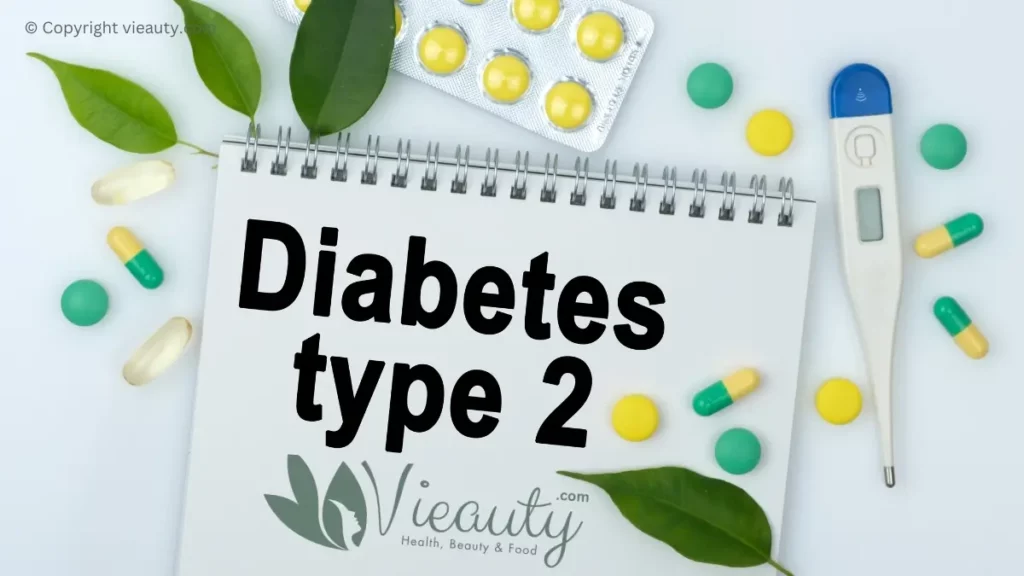Type 2 Diabetes Symptoms and Causes
Type 2 diabetes is a serious health condition that affects millions of people around the world. Unfortunately, not everyone has the same symptoms and causes for this condition. It is important to understand what type 2 diabetes is, what its symptoms are, and what are the potential causes. With this article, you will learn more about type 2 diabetes, including symptoms such as increased thirst and fatigue, as well as potential causes such as genetics and lifestyle choices.
Table of Contents
- Definition of Diabetes
- Brief overview of Types of Diabetes
- What is Type 2 Diabetes?
- Causes and Risk Factors for Type 2 Diabetes
- What is Insulin resistance in Type 2 Diabetes
- Symptoms of Type 2 Diabetes
- Complications of Type 2 Diabetes
- Diagnosing Type 2 Diabetes
- Treatment and Management of Type 2 Diabetes
- Conclusion
Definition of Diabetes
Diabetes is a chronic health condition that occurs when the body either cannot produce enough insulin or cannot use the insulin it produces properly. Insulin is a hormone that regulates blood sugar levels by allowing glucose to enter the cells of the body, where it is used as a source of energy.
There are two main types of diabetes: type 1 diabetes, which is often diagnosed during childhood or adolescence and is characterized by the inability of the body to produce insulin, and type 2 diabetes, which commonly develops in adulthood and is often associated with obesity and a sedentary lifestyle.

Symptoms of diabetes include increased thirst, frequent urination, unexplained weight loss, blurred vision, and a range of other complications that can lead to serious health issues if left untreated. Treatment and management of diabetes require regular blood sugar monitoring, insulin injections or medication, healthy eating habits, and regular physical activity.
Brief overview of Types of Diabetes
There are three main types of diabetes, all of which involve issues with the body’s ability to regulate blood glucose levels. Type 1 diabetes is typically diagnosed in childhood and is caused by the body’s immune system attacking and destroying insulin-producing cells in the pancreas. People with type 1 diabetes need to regularly monitor their blood sugar levels and take insulin to manage their condition.
Type 2 diabetes is the most common form and usually develops in adulthood. It is often linked to lifestyle factors such as diet and exercise, and can be managed through diabetes care such as diet and exercise changes, medication or insulin.
Gestational diabetes affects pregnant women and typically goes away after childbirth, but it can increase the risk of developing type 2 diabetes later in life. High blood sugar can lead to health complications, so it’s important for people with diabetes to regularly check their blood glucose levels and take steps to manage their condition. Check our detailed guide below.
What is Type 2 Diabetes?
Type 2 diabetes is a chronic condition that affects millions of people worldwide. It is characterized by high levels of sugar in the blood due to a lack of insulin production or the inability of the body to use insulin effectively. People with type 2 diabetes have an increased risk of developing complications such as heart disease, nerve damage, and damage to blood vessels.

Managing diabetes involves adopting a healthy lifestyle, including regular physical activity, a balanced diet, and consistent glucose monitoring. In some cases, diabetes medication may be necessary to control blood sugar levels. It is crucial for people with type 2 diabetes to take steps to prevent and manage complications by maintaining optimal blood sugar control and working closely with their healthcare team. By doing so, they can live a full and healthy life despite having a chronic condition.
Causes and Risk Factors for Type 2 Diabetes
Type 2 diabetes is a complex metabolic disorder that results in high blood sugar levels. The condition develops when the body becomes resistant to insulin or is unable to produce enough insulin to regulate blood sugar levels.
Multiple factors contribute to the development of type 2 diabetes, including genetics, lifestyle choices, and environmental factors. Some of the most significant risk factors for developing type 2 diabetes include being overweight or obese, having a family history of diabetes, being over the age of 45, having a sedentary lifestyle, and smoking.
Other factors that can exacerbate the development of type 2 diabetes include high blood pressure, high cholesterol levels, and a diet high in processed foods and sugars. While some risk factors, such as genetics, cannot be changed, lifestyle modifications such as regular exercise, a healthy diet, and maintaining a healthy weight can help prevent or manage the condition.
What is Insulin resistance in Type 2 Diabetes
Insulin resistance is a condition in which the body’s cells become resistant to insulin, a hormone produced by the pancreas that helps regulate blood sugar levels. In people with Type 2 Diabetes, insulin resistance causes glucose to build up in the bloodstream, leading to high blood sugar levels. This can cause a range of health problems over time, including heart disease, kidney damage, nerve damage, and vision loss.
Insulin resistance is often caused by factors such as obesity, physical inactivity, and a diet high in processed foods and sugar. Treatment for insulin resistance may involve lifestyle changes such as increasing physical activity and improving diet, as well as medications to help regulate blood sugar levels.
Symptoms of Type 2 Diabetes
A. Early Symptoms
The early symptoms of type 2 diabetes may go unnoticed for a long time, but when left untreated, they can progress into severe health problems. Some of the earliest symptoms include frequent urination, increased thirst, and fatigue.
When your body becomes insulin resistant, it struggles to process glucose effectively, causing excess glucose to build up in your bloodstream. This leads to frequent urination as your body tries to flush out the excess glucose through urine. As a result, you can get dehydrated easily, which leads to increased thirst.
Fatigue can also be caused by the body struggling to process glucose, leading to lower energy levels. If you are experiencing any of these symptoms, make sure to consult with a doctor, who can run some tests and monitor your blood glucose levels.
B. Later Symptoms of type 2 diabetes
Later symptoms of type 2 diabetes include blurred vision, slow healing wounds, and numbness or tingling in hands or feet. Blurred vision is caused by high blood sugar levels, which can damage blood vessels in the eyes. Slow healing wounds are a result of poor blood flow caused by damaged blood vessels. This can lead to infections that are slow to heal and increase the risk of amputation.
Numbness or tingling in hands or feet, also known as neuropathy, is caused by nerve damage that is commonly associated with long-term high blood sugar. As type 2 diabetes progresses, these symptoms can exacerbate, and it is important to monitor blood sugar levels and seek medical advice if experiencing any of these symptoms.
Early detection and management of type 2 diabetes can reduce the risk of complications and improve quality of life. So, people with these symptoms should take the necessary steps to maintain a healthy lifestyle, including regular exercise, a balanced diet, and routine health checkups.
Complications of Type 2 Diabetes
A. Short-Term Complications
1. Hypoglycemia
Hypoglycemia is a short-term complication of Type 2 Diabetes that occurs when blood sugar levels drop too low. Symptoms of hypoglycemia can range from mild to severe and include shakiness, sweating, rapid heartbeat, confusion, and even seizures or loss of consciousness in severe cases. Hypoglycemia can occur when insulin and glucose levels are not balanced, such as after exercising or when taking certain medications for diabetes. While hypoglycemia can be easily treated with glucose tablets or other foods high in sugar, it is important to monitor blood sugar levels regularly and seek medical attention if symptoms become severe. Taking precautions such as carrying a source of glucose with you and informing others around you of your diabetes can also help prevent and manage hypoglycemic episodes.
2. Hyperglycemia
It can include hyperglycemia, which occurs when blood sugar levels become too high. This can happen if a person with type 2 diabetes eats high-carbohydrate foods, skips or delays doses of medication or insulin, or experiences stress or illness. Symptoms of hyperglycemia can include frequent urination, increased thirst, blurred vision, fatigue, and headache.
If left untreated, hyperglycemia can lead to more serious complications such as diabetic ketoacidosis, a condition in which the body produces high levels of blood acids called ketones. It is important for those with type 2 diabetes to monitor their blood sugar levels regularly, follow a healthy diet and exercise regimen, and take medications as prescribed to avoid hyperglycemia and other short-term complications.
3. Diabetic Ketoacidosis
Diabetic ketoacidosis is a short-term complication of type 2 diabetes that can be life-threatening if left untreated. It occurs when the body breaks down fats and produces ketones for energy because there isn’t enough insulin to process glucose for energy. The buildup of ketones in the blood can make it acidic and cause a wide range of symptoms, including excessive thirst, frequent urination, nausea, vomiting, confusion, and abdominal pain.
These symptoms can escalate quickly and lead to a diabetic coma or even death. Diabetic ketoacidosis requires immediate medical attention with intravenous fluids, insulin therapy, and electrolyte replacement. It is important for individuals with type 2 diabetes to monitor their blood sugar levels regularly and seek medical attention immediately if they experience any of the symptoms.
B. Long-Term Complications
1. Cardiovascular Disease
Type 2 diabetes is a chronic metabolic disorder that affects the body’s ability to use insulin efficiently, causing high blood sugar levels. Over time, high blood sugar levels can cause long-term complications, including cardiovascular disease. Cardiovascular disease is a group of conditions that affect the heart and blood vessels, such as coronary artery disease, heart failure, and stroke.
People with Type 2 diabetes have a higher risk of developing cardiovascular disease because high blood sugar levels can damage the blood vessels and organs of the body. Additionally, high blood pressure, high cholesterol levels, obesity, and physical inactivity, which are all common in people with Type 2 diabetes, can increase the risk of cardiovascular disease. It is crucial for people with Type 2 diabetes to manage their blood sugar levels and adopt a healthy lifestyle to prevent or delay the onset of cardiovascular disease.
2. Neuropathy
One of the long-term complications of Type 2 diabetes is neuropathy, which causes damage to the nerves that connect the brain and spinal cord to other body parts. Over time, high blood sugar levels damage the blood vessels that supply oxygen and nutrients to the nerves, leading to neuropathy. Symptoms of neuropathy can include tingling, numbness, and burning pain, especially in the hands and feet.
Neuropathy can also affect other parts of the body, such as the digestive system, causing constipation or diarrhea, and the urinary system, causing urinary tract infections or incontinence. Neuropathy can significantly reduce a person’s quality of life, as even simple movements can become difficult or painful. Therefore, it is essential for people with Type 2 diabetes to manage their blood sugar levels carefully to prevent or minimize the risk of neuropathy and other long-term complications.
3. Kidney Disease
Poorly managed type 2 diabetes can lead to various long-term complications, among them being kidney disease. High blood sugar levels damage the small blood vessels in the kidneys, which can sometimes result in impaired kidney function. In extreme situations, kidney disease can cause kidney failure, requiring dialysis or even a transplant. Signs of kidney disease include swelling in the legs and feet, nausea, vomiting, and fatigue. Therefore, to prevent kidney disease, it’s crucial to maintain good blood sugar control, take prescribed medications as directed, maintain a healthy diet, exercise regularly, and attend regular medical check-ups to ensure early diagnosis and intervention if required.
Diagnosing Type 2 Diabetes
A. Diagnosing Type 2 Diabetes from Medical History Diagnosing Type 2 Diabetes from Medical History is a crucial step in detecting diabetes. It involves collecting information about the patient’s family history related to diabetes, their lifestyle factors like sedentary behavior, unhealthy diets, and excessive weight gain. In addition, factors that can trigger the onset of diabetes like high blood pressure, high cholesterol, and gestational diabetes during pregnancy are taken into account.
Type 2 Diabetes diagnosis also includes a comprehensive medical test to measure fasting glucose levels, A1C levels, and oral glucose tolerance test. This testing process helps medical practitioners confirm the diagnosis of type 2 diabetes and determine the appropriate medical care, including medications, lifestyle changes, and diet modifications. However, early diagnosis and treatment of type 2 diabetes can prevent long-term medical complications and improve patient outcomes.
B. Diagnosing Type 2 Diabetes from Physical Exam
Diagnosing this Diabetes from a physical examination is a process that involves looking for common signs and symptoms. The examination may involve checking the blood pressure, weight, and height of the patient. A physical assessment may also involve assessing the skin, eyes, feet, and hands for any signs of nerve damage or circulation problems.
Doctors may also order blood tests to measure blood glucose levels and detect other health issues that can either cause or complicate Type 2 Diabetes. Another important aspect of diagnosis involves checking family history and lifestyle risk factors such as diet, physical activity level, and smoking. By combining all these diagnostic components, physicians can effectively diagnose Type 2 Diabetes, and plan the most appropriate management approach.
C. Diagnosing Type 2 Diabetes from Blood Test
Type 2 diabetes is a chronic condition that affects how your body processes blood sugar or glucose. With the help of a blood test, doctors can diagnose this condition in patients.
The blood test measures the blood glucose level and is called a fasting plasma glucose test. A result of 126 mg/dL or higher on two separate occasions is an indication of type 2 diabetes. In addition to the fasting plasma glucose test, people may undergo a glycated hemoglobin (A1C) test, which measures the average blood sugar level over several months. A result of 6.5% or higher on two separate occasions is a sign of type 2 diabetes.
Some patients may receive an oral glucose tolerance test, which measures the response of the body’s insulin to a glucose load. Doctors may also monitor the patient’s weight, blood pressure, and cholesterol levels to determine the severity of the condition. Diagnosing type 2 diabetes early is essential for effective treatment and management.
D. Diagnosing Type 2 Diabetes from Glucose Tolerance Test Diagnosing type 2 diabetes requires a thorough examination that may include a glucose tolerance test. During the test, you will be required to drink a sugary drink, and then, after a certain period, a blood sample will be taken to assess your glucose level. The test allows the doctor to monitor your body’s ability to regulate glucose levels over time, making it easier to diagnose type 2 diabetes.
If your glucose level remains high, it may be indicative of diabetes. Post-diagnosis, lifestyle changes, particularly in the areas of diet and exercise, are critical in managing type 2 diabetes. Early diagnosis and adherence to a healthy lifestyle can lessen the severity of complications that may arise later. Regular follow-up consultations with an experienced doctor can help you manage the condition and improve your quality of life.
E. A1C Test
The A1C test is a widely used diagnostic tool to determine the presence of Type 2 diabetes in patients. This test measures the percentage of glycated hemoglobin in the blood which provides an estimate of the blood sugar levels over the past few months. A reading of 6.5% or higher indicates that a patient has diabetes. The A1C test is particularly useful in detecting diabetes as it does not require fasting, unlike other tests such as the fasting plasma glucose test.
The A1C test is also beneficial in tracking the effectiveness of diabetes management over time. However, it is important to note that the A1C test may not be as accurate in certain individuals such as those with anemia, sickle cell disease, or chronic kidney disease. In such cases, alternative tests may be required for accurate diagnosis.
Treatment and Management of Type 2 Diabetes
A. Treatment and Management of Type 2 Diabetes with Lifestyle Changes
Type 2 diabetes is a serious condition that requires ongoing treatment and management. Lifestyle changes are a key aspect of treatment, and there are several strategies that can be used to improve outcomes. One key strategy is diet modification, which involves making changes to the foods that are consumed in order to improve blood sugar levels and manage weight.
Another strategy is exercise, which can help to improve insulin sensitivity and promote overall health. Smoking cessation is also important, as smoking can exacerbate the complications associated with diabetes. Finally, stress management techniques such as meditation or yoga can be beneficial in reducing stress and improving overall well-being. Overall, these lifestyle changes can be highly effective in improving outcomes for individuals with type 2 diabetes, and are a critical component of ongoing care.
B. Treatment and Management of Type 2 Diabetes with Medications
Type 2 diabetes is a chronic condition that requires lifelong management for maintaining normal blood sugar levels. Medications play a crucial role in the treatment and management of this condition. There are two main types of diabetes medications – oral medications and insulin therapy. Oral medications are taken by mouth that helps blood sugar levels to stay in control by lowering insulin resistance and increasing the production of insulin. These include biguanides, sulfonylureas, meglitinides, DPP-4 inhibitors, SGLT2 inhibitors, and TZD’s.
Insulin therapy would be necessary when oral medications alone are insufficient to control blood sugar levels. Insulin is injected into the body through the use of a pen, a syringe, or a pump. Furthermore, it is important for people with type 2 diabetes to visit the doctor on a regular basis to monitor their blood sugar levels and manage any complications that may arise. By following these guidelines, people can manage their Type 2 diabetes effectively and lead a healthy and normal life.
Conclusion
Type 2 diabetes is a chronic metabolic disorder that usually affects adults. It occurs when the body cannot efficiently use insulin, leading to high blood sugar levels. Symptoms typically include frequent urination, excessive thirst, hunger, blurred vision, and fatigue. Unfortunately, these symptoms may not appear at first, or may be mistaken for other illnesses, so early diagnosis is crucial.
It is important to get tested for diabetes as early as possible, especially if you are at risk due to factors such as obesity, physical inactivity, or family history of diabetes. With early detection, diabetes can be managed with dietary changes, physical activity, and medications.
If left untreated, however, it can lead to serious complications such as blindness, kidney damage, and cardiovascular disease. Therefore, if you suspect you may have diabetes, it is important to consult your healthcare provider as soon as possible to receive proper diagnosis and treatment. Don’t wait to take action to control your diabetes!






